Subtle Archives and Subversions: Akshay Mahajan on Kaghazi Pairahan
An exhibition as a site produces and holds multiple premises within its intentions, including, but not limited to, those facilitated by its curatorial vision. Depending on what it wishes to initiate and instigate, it morphs into a collaborative canvas. In this manner, an exhibition presents and invites varying levels of affective engagement across its interfaces and its many modes of encounter and departure. Looking closely at one such itinerant site hosted at the doubledummy Studio, during the Rencontres d’Arles 2023—Kaghazi Pairahan, curated by Akshay Mahajan and Devadeep Gupta, produced by Editions JOJO—the following interview unpacks the way circuits of reading, publishing, dissemination and viewership accumulate in porous forms within an archive of everyday resistance.
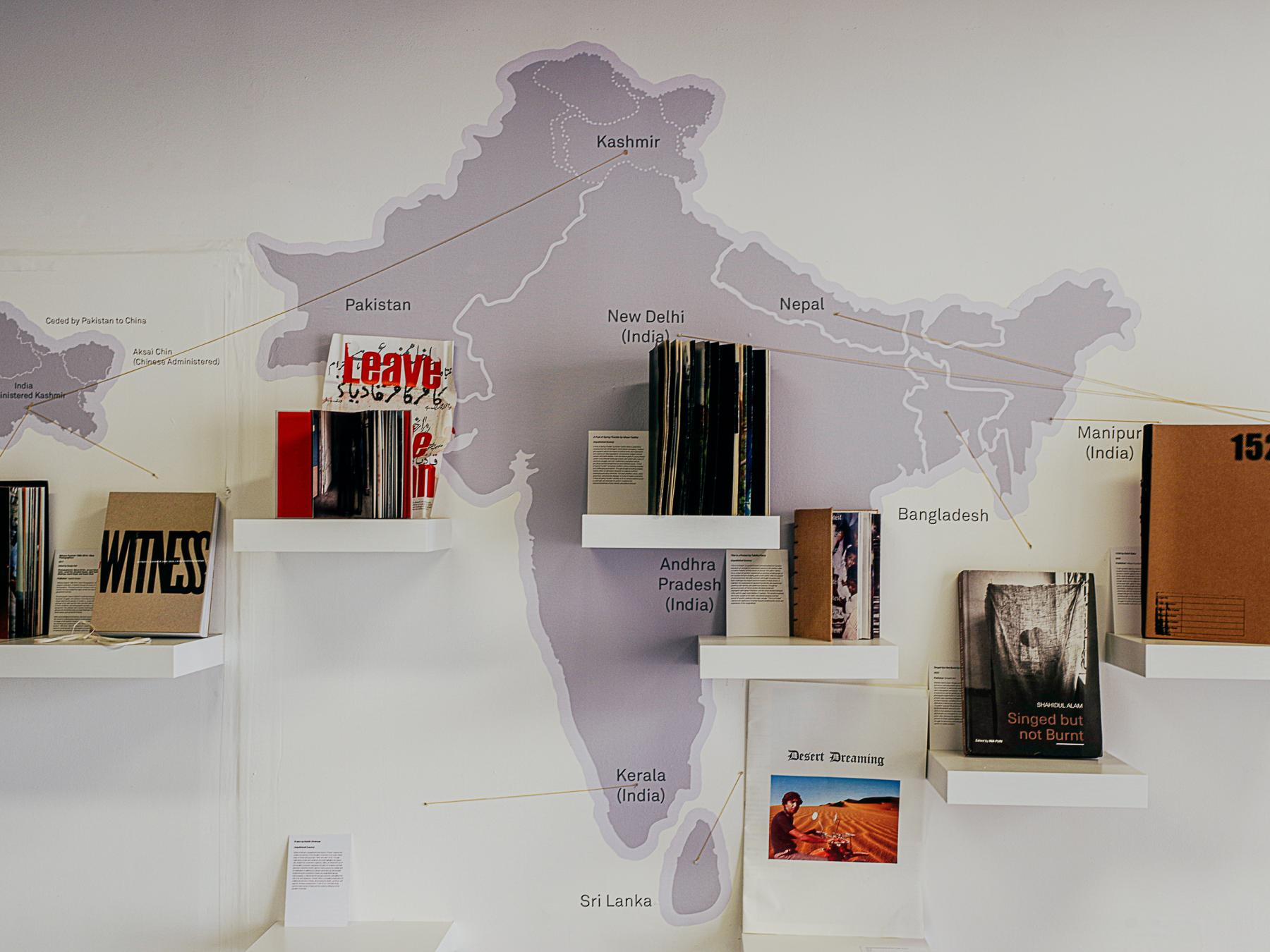
Exhibition display from Kaghazi Pairahan.
Foregrounding the significance of artistic protest in Pakistan, India, Kashmir, Nepal, Sri Lanka, and Bangladesh, Kaghazi Pairahan thinks of how making can be construed, shaped and claimed in a time of crisis through testimony, the production of critique around concepts of social transformation and citizenship, as well as contemporary reflections on the subtleties of resistance. Across a library of photobooks, dummies, artist books, zines, posters, pamphlets and digital publications, the exhibition reflects on the role of mediums and media today. In this edited excerpt, co-curator Akshay Mahajan speaks about ways of documenting that assert challenges, subversions and advocacies amassed through a growing vocabulary of collective dissent and defiance.
Annalisa Mansukhani (AM): Can you tell us about the concept and inspiration behind Kaghazi Pairahan? How did this collaboration take shape?
Akshay Mahajan (AkM): Kaghazi Pairahan is a travelling library and exhibition that showcases a collection of photobooks, unpublished dummies, artist books, zines and digital publications, with the aim of weaving together stories and histories of resistance in South Asia. The space provides an archive of resistance that is both personal and political, historical and contemporary. It offers alternative and progressive viewpoints, often as a form of artist’s protest. Here, the published image turns into a symbolic Kaghazi Pairahan (Clothes made of Paper), referring to an ancient custom in Persia where seekers of justice put on paper garments when appearing before the ruler.
The seed for the collaboration was sown in 2022, when Mathieu Asselin, a celebrated documentary photographer, joined forces with Kaamna Patel, the artist and driving force behind Editions JOJO, an artist imprint and photobook library. Asselin has garnered widespread acclaim for his research-based photography projects that serve as powerful acts of protest and engagement. His project, Monsanto: A Photographic Investigation, published by Actes Sud, received significant recognition.
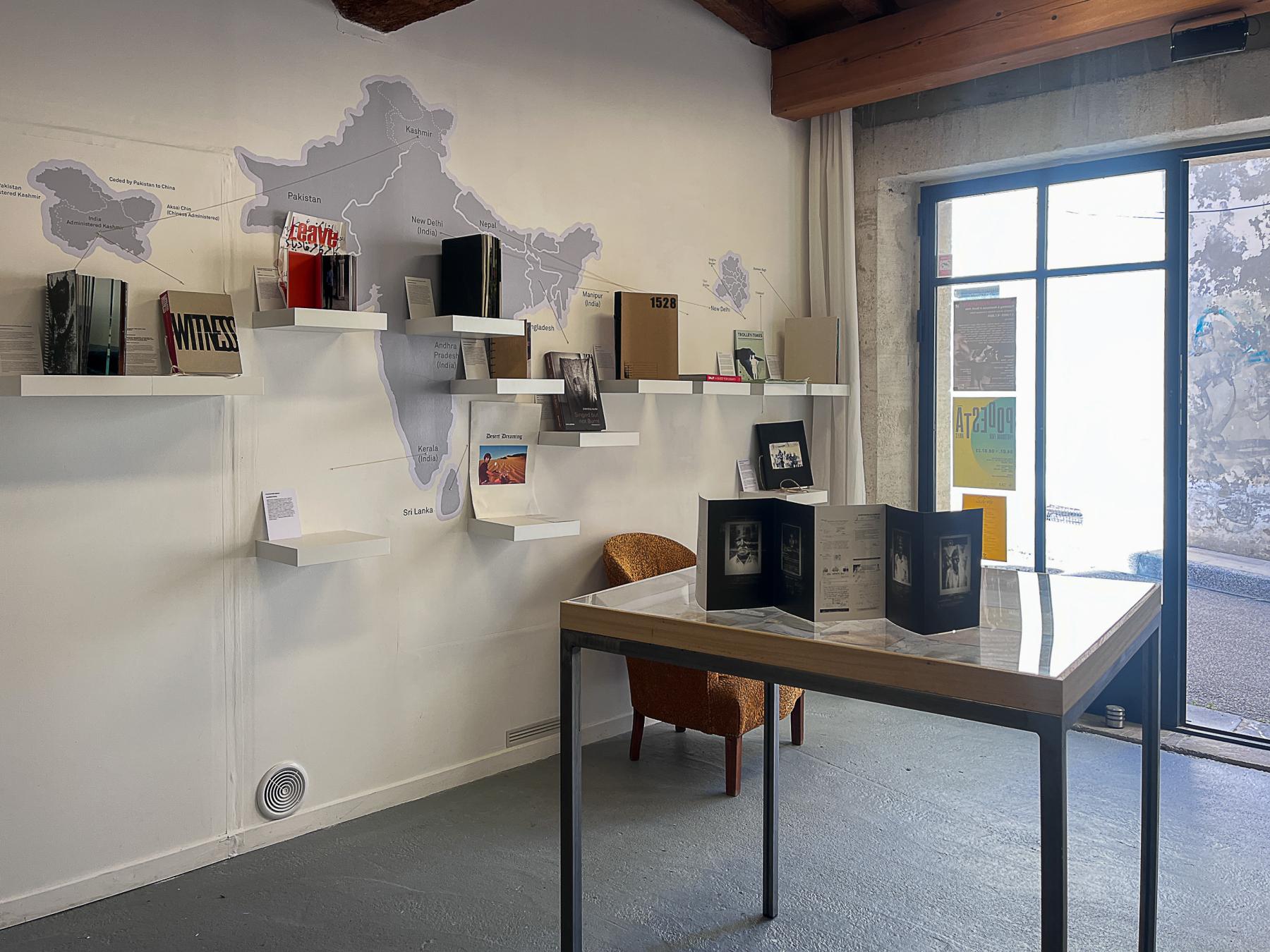
Installation shot from the space. As part of the reading room, Kaghazi Pairahan presented a mapping of the regions from which several of the publications stemmed, allowing for a fertile visualisation of the scope of the travelling library.
The collaboration evolved through a series of enriching interactions, including talks and workshops in India. These conversations expanded with the involvement of Sergio Valenzuela-Escobedo and Gupta as we engaged in insightful discussions about photographic works within South Asia that explore paradigms of protest and resistance. These eventually gave birth to the concept of Kaghazi Pairahan, amplifying the voices of individuals who have fearlessly resisted injustice and inequality in the region.
Our first goal was to activate doubledummy Studio, a space created by Asselin and Valenzuela-Escobedo to showcase thought-provoking reflections on documentary photography. The exhibition, designed by Adira Thekkuveettil and curated by Gupta and me, intended to deeply engage with protest and research-based photography. Furthermore, we commissioned an exhibition essay by Tanvi Mishra, which was to be printed as a newspaper in Berliner format. The exhibition prominently featured photobooks, along with other forms like zines and artist books, each representing a powerful testimony, a personal protest, or a simple act of bearing witness.
AM: How did you arrive at the idea of a travelling library, especially one that would communicate its archival intentions while also acting as a reading room? What were some key urgencies behind the conceptual and spatial framing of this project?
AkM: The idea of a travelling library and reading room emerged from our recognition of the historical and contemporary significance of protest and resistance in South Asia. It has long been a region where various forms of dissent have thrived and evolved. From the early days of Civil Disobedience to broader civil rights movements, South Asia has witnessed fierce resistance against discrimination and colonial subjugation historically, as well as more recent struggles against authoritarianism and corporate interests.
The urgency behind the conceptual and spatial framing of this project lies in the desire to explore the role of images and their derivatives in these trajectories of protest and resistance. By examining the historicity of these movements and linking them to the present day, our project seeks to channel the spirit and ethos of the struggles that have shaped South Asia. The reading room embodies the Urdu word “inquilab” (revolution/change) and its variant meaning(s) in the subcontinent, presenting a broader vision of societal transformation and encapsulating the spirit of change and upheaval.
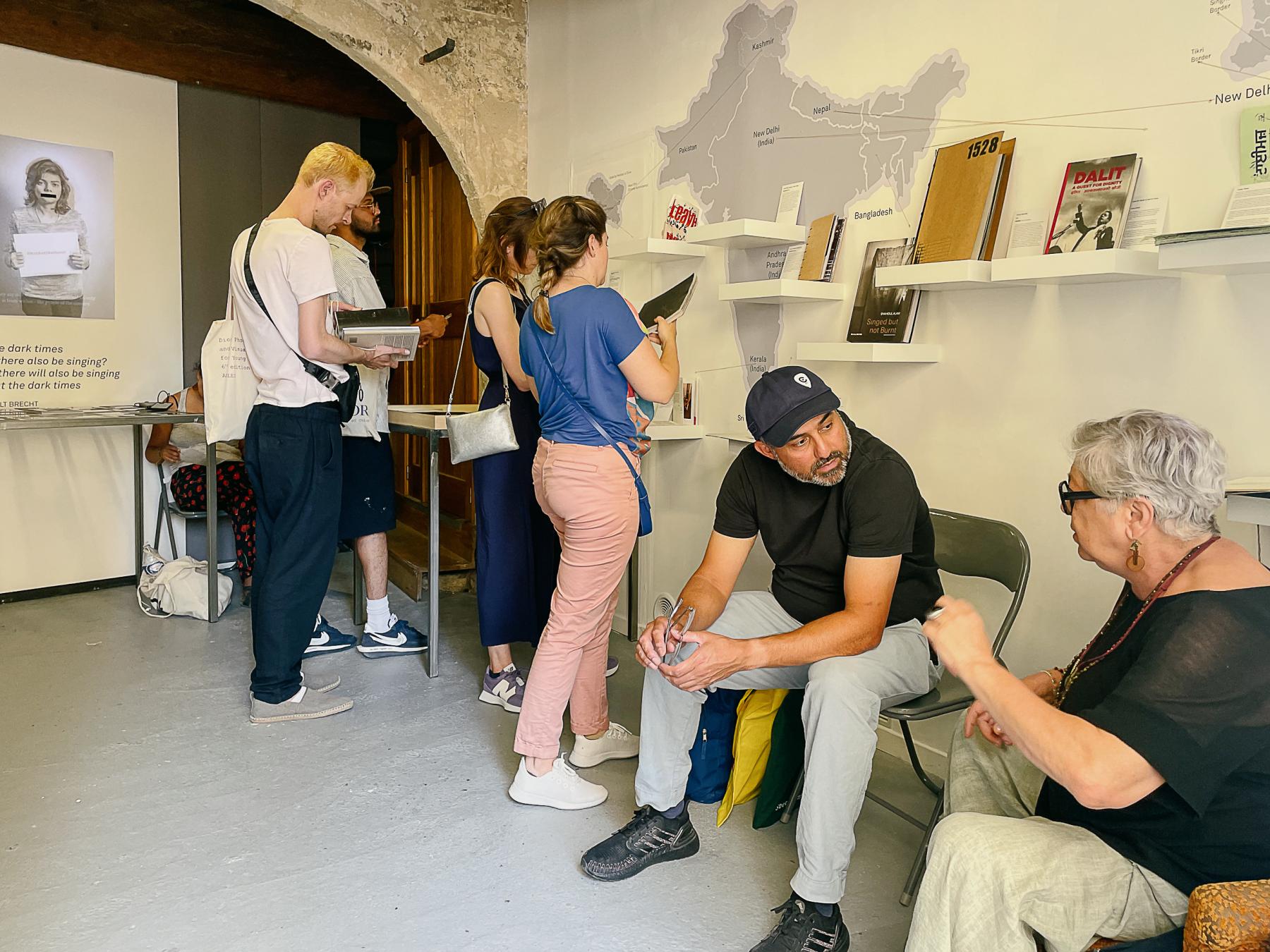
Visitors browsing books at Kaghazi Pairahan.
In the exhibition, each published object served as a testimonial, with the authors taking on the role of “inquilabis” (harbingers of change). The publications became symbolic artefacts, akin to lighting a torch in the day, a candlelight vigil, a letter to oneself, or carrying a blood-soaked cloth on a bamboo pole to protest injustice.
This became a guide for us to set out archival intentions by featuring publications like The Uprising of 1857, published by the Alkazi Foundation for the Arts. The book illustrates not only the early resistance against colonial rule in India but also showcases rare archival photographs from the Alkazi Collection, a marker for the early use of photography only two decades into its commercial inception. Another photobook in the exhibition, Tabitha Percy's unpublished dummy This is a Protest, is pivotal in examining the afterimage of Dr BR Ambedkar’s wide-reaching ideology of liberation that sought the emancipation of people historically repressed by caste. The dummy rethinks the archive to serve as a commemoration of the Tsunduru massacre, an example of caste-based violence in Andhra Pradesh, and stories of survival. Using archival material and family albums, it explores generational trauma caused by caste violence while simultaneously honouring those who died, survived, and fought for justice. The foldout zine, titled Women of Leisure by the Northeast Lightbox, looks at the archives of the Tezpur Mahila Samiti, a historical feminist organisation in Assam. The publication examines their archives, amateur theatre and music to celebrate the power of female friendships, safe spaces and collective expression.
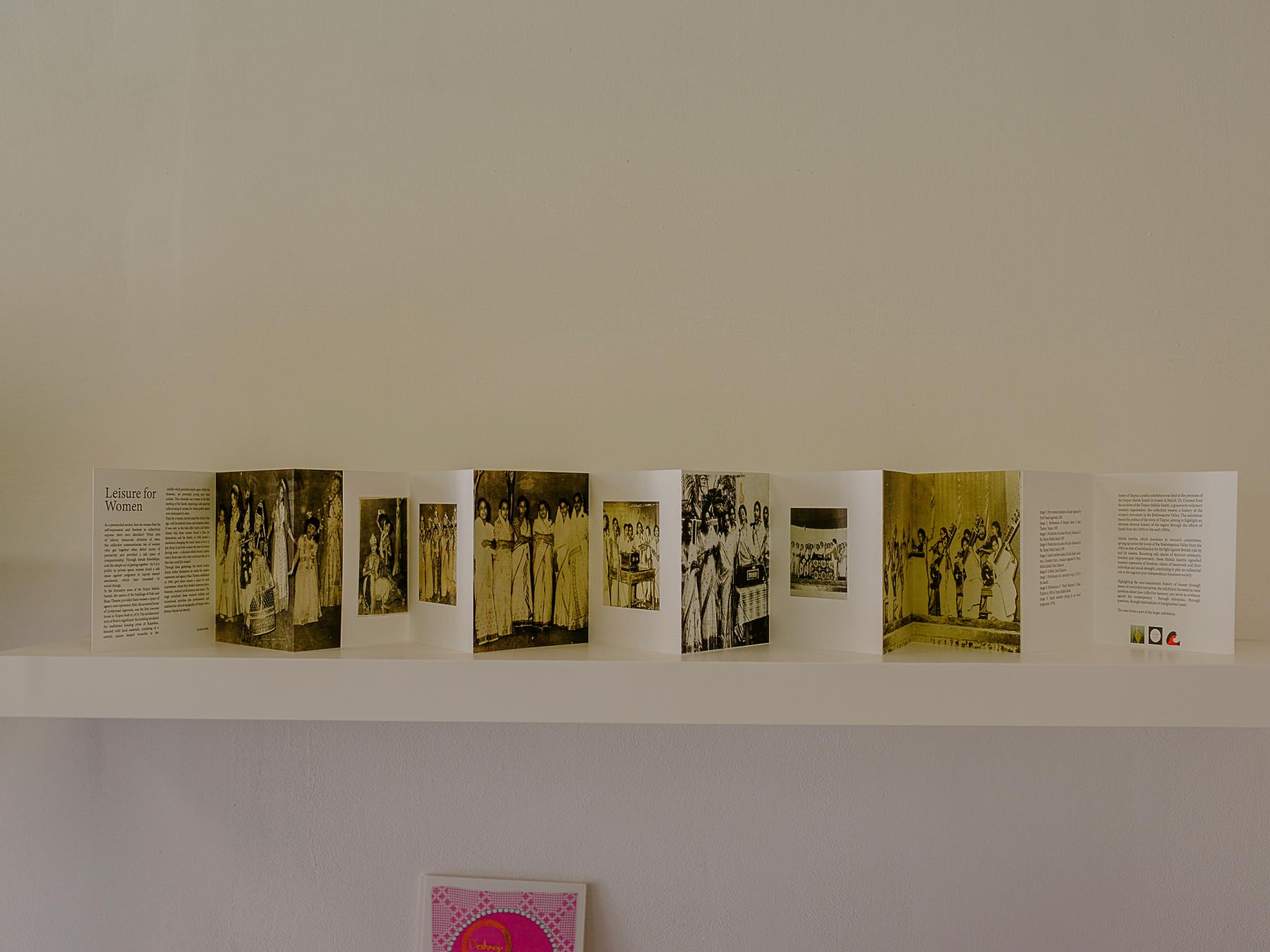
Women of Leisure, a foldout zine by the Northeast Lightbox, looks at the archives of the Tezpur Mahila Samiti, a historical feminist organisation in Assam.
AM: Apart from historical material, the exhibition features works by a new generation of artists. Could you tell us about some of these works and their significance in the context of the theme of resistance?
AkM: One of the reasons for conceiving this exhibition is the abundance of material that exists in South Asia, particularly from a new generation of artists who actively document protests and social movements with great sensitivity and criticality. It is essential to note that many of these works have remained unpublished for various reasons.
For instance, Siva Sai Jeevanantham's work In The Same River explores conflict in Kashmir through the lenses of memory, resistance and political injustice. In collaboration with the Association of Parents of Disappeared Persons (APDP), Jeevanantham visited 100 families in Kashmir, conducting interviews as well as examining photographs and documents. The resulting publication is an archive that preserves these materials as an act of political resistance, demanding justice and defying erasure.
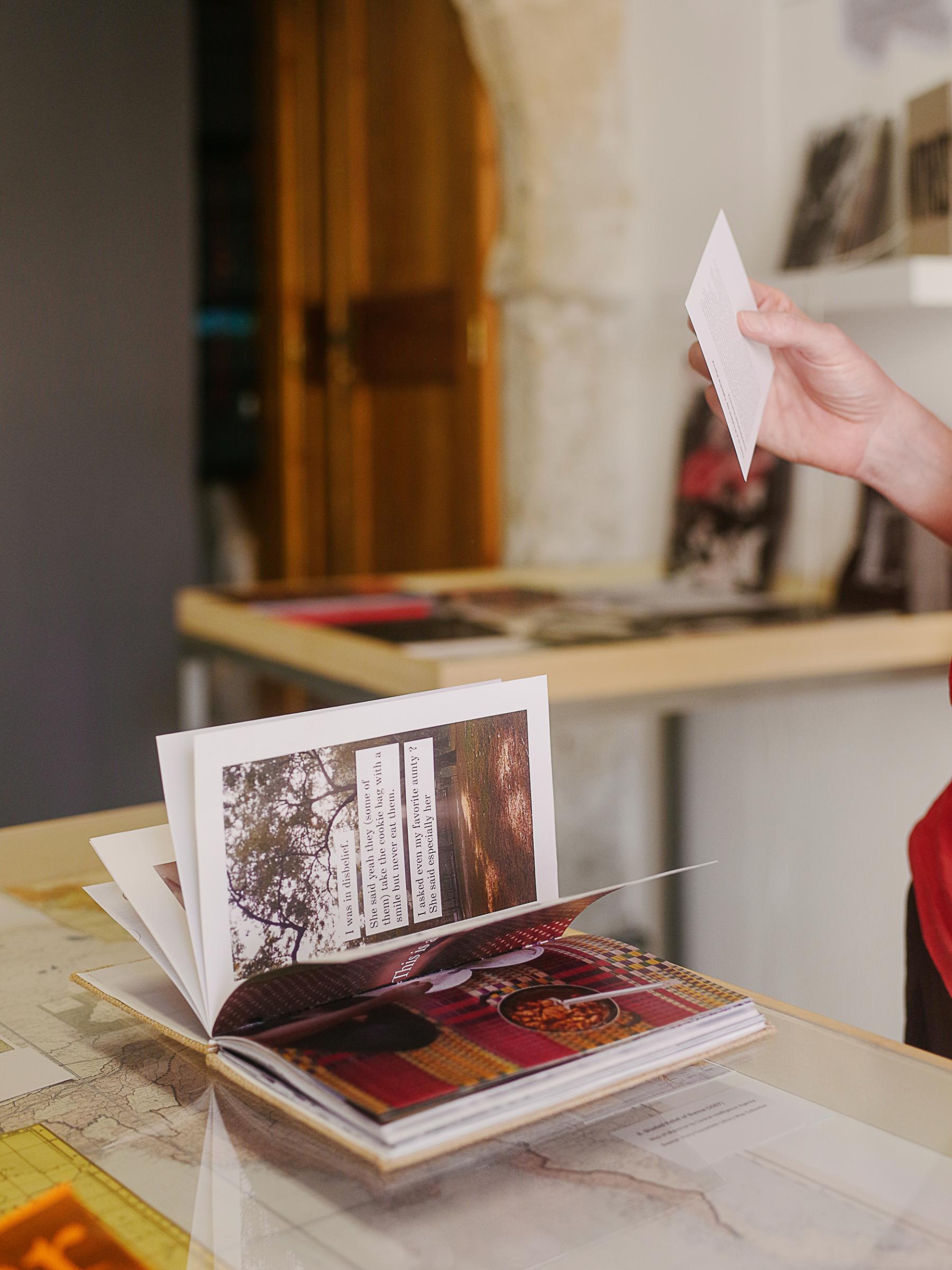
Display from Kaghazi Pairahan featuring Tabitha Percy's unpublished dummy, This is a Protest, which serves as a commemoration of the Tsunduru massacre.
Another unpublished dummy, Haal Mureeda Da, by Gulmehar Dhillon, is a meticulously handmade book that delves into the tragic events following the assassination of Indira Gandhi in October 1984. Focusing on violence against the Sikh community in India, Dhillon, who was raised in a Sikh household, seeks to comprehend the subsequent anti-Sikh pogrom and its profound impact on survivors. The resulting book is a research and protest journal that adopts a multidimensional approach, utilising photographs, archival documents, reports, testimonies and personal reflections.
Some works in the show explore different aspects of identity. Abdul Halik Azeez's Desert Dreaming uses collage and mixed media to explore his cultural belonging and what it means to be Sinhalese Muslim in a world shaped by 9/11 and post-war Islamophobia in Sri Lanka. A Survival Guide for Ahmadi Muslims of Pakistan by Nida Mehboob presents tableaus that examine forms of discrimination faced by the community, and subsequent laws criminalising their faith. Ayan Farooqui's zine Scapegoat offers photographs of goats in various urban landscapes, but beyond the obvious, it presents a profound exploration of the societal impact of blame. With a sense of dark humour in the face of polarisation and Islamophobia, it asks the question: does society truly require a scapegoat to channel aggression and foster cohesion?
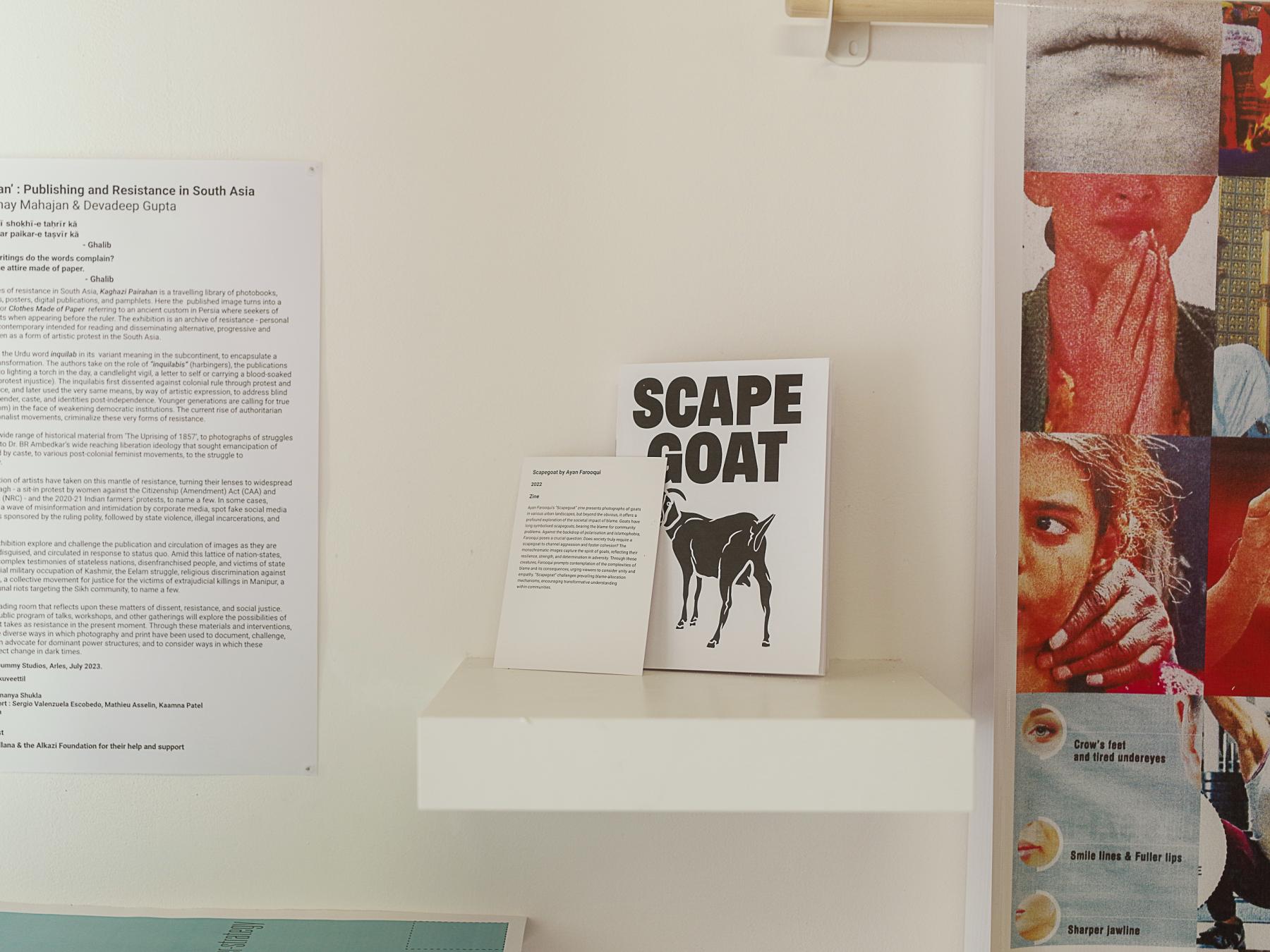
Display from Kaghazi Pairahan featuring Ayan Farooqui's zine Scapegoat, which explores the societal impact of blame and questions the necessity of a scapegoat.
Other artists have focused their attention on events such as the Shaheen Bagh sit-in protest and the Indian farmers' protests of 2020–21. An example of a hybrid publication is the Trolley Times, a bilingual newspaper created for farmers at the protest site. Launched in 2020, the Trolley Times captured the spirit of protests against the new farm laws. It emerged as a powerful voice during recent farmers' protests in India, reminiscent of historical newspapers associated with past movements.
These works, along with others in the exhibition, delve into the complexities of such politically charged movements, addressing misinformation, media manipulation and state violence against marginalised communities. Through photography and print, the artists challenge the publication and circulation of images, recontextualising and archiving them to resist the status quo. The exhibition explores the struggles of stateless nations, victims of state violence, and individuals facing religious discrimination, extrajudicial killings and communal riots. By compiling these narratives, the artists shed light on the experiences of the disenfranchised and challenge dominant power structures.
2.png)
Trolley Times, a bilingual newspaper created for farmers during their protests in 2020, captured the resilience and able leadership of farmers and farmworker organisations as they rallied against the new farm laws.
Kaghazi Pairahan is supported by Arthshila, and will be showcased across all Arthshila centres in India in 2024.
To read more about Akshay Mahajan’s work, revisit his two-part conversation on the Goa Familia project, which he co-curated with Lina Vincent, as well as a walkthrough of an iteration of the project at the Serendipity Arts Festival in 2022.
To read more about the 2023 edition of Rencontres d’Arles, revisit Sukanya Baskar’s reflection on Tanvi Mishra’s curatorial interventions and Annalisa Mansukhani’s two-part interview with Soumya Sankar Bose on his work A Discreet Exit through Darkness, which won the Louis Roederer Foundation Public Award.
All images courtesy of Devadeep Gupta and Akshay Mahajan.




